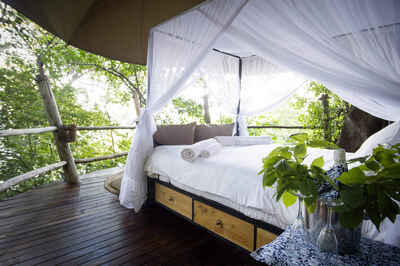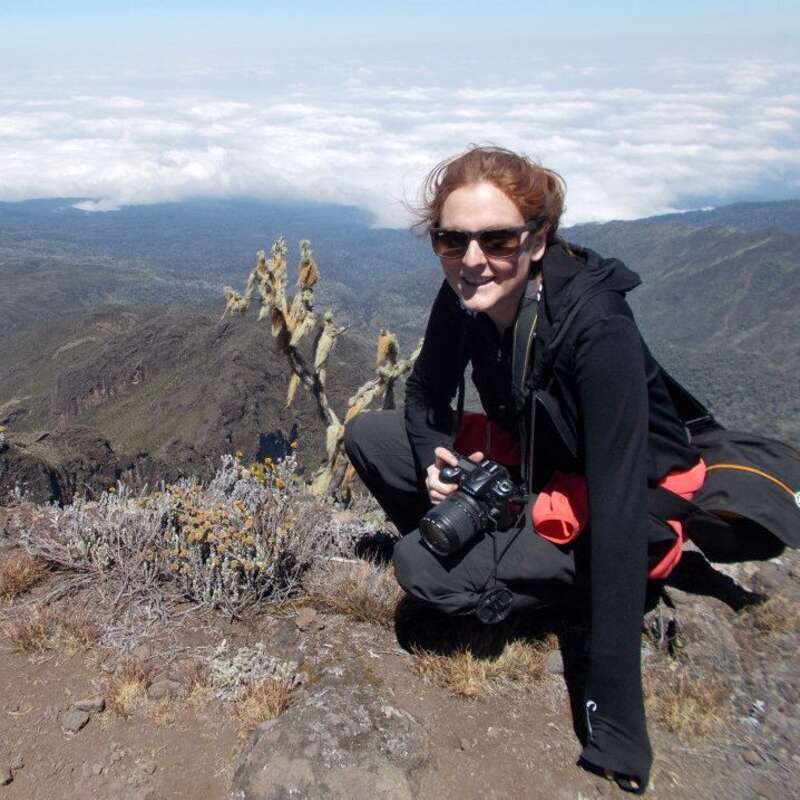About Rubondo Island Camp
Part way between a safari lodge and a secluded beach retreat, Rubondo Island offers a unique take on Tanzania.
As desert islands go, Rubondo Island – complete with its own safari camp – is in a class of its own. Flying in over Lake Victoria reveals the sheer remoteness of this camp, set on the sandy lakeshore against a backdrop of tropical forest. Take a walk into the forest with a keen guide and you’ll be immersed in a birding hinterland, with some 300 species vying for your attention. You can seek out the troop of chimpanzees that roams the island, too, or bump along dirt roads in a 4x4, following the tracks of elephant, giraffe and even sitatunga. On the water, boats are on hand to ferry you to neighbouring islands, and there are fishing options aplenty. But you don’t have to go far to appreciate this island hideaway. Just a few steps from the simple but stylish rooms and you’ll have your toes in the sand, watched over by fish eagles and sheltered by towering fig trees, while up on a rocky headland you can take in the views from an open-plan structure that blends almost seamlessly into the environment. Start the day with breakfast facing the sunrise, and finish with dinner on the beach; this is above all a place to relax.
Our view
Rubondo Island Camp is not the place for those seeking big game, guaranteed sightings of chimps, or back-to-back activities. However, it's wild, remote, off the beaten track and a truly lovely camp to relax and spend time just enjoying nature, with a flexible schedule. You can explore by boat and on foot, as well as by vehicle, and we think it would be a perfect last stop after a busy safari – or possibly a more nature-oriented alternative to Zanzibar. At times it felt a little unorganised but for the relaxed traveller, perhaps already familiar with the usual spots in East Africa, it has a lot to offer.
Accommodation
8 rooms
Children
Best for 12+
Open
Year Round
Activities

4WD Safari

Birdwatching

Boat trip

Fishing

Fly-camping

Guided walking safari

Kayaking

Primate trekking

Private activities
Traveller reviews of Rubondo Island Camp
6 real, un-edited reviews from Expert Africa's travellers.
Arrived 27 Jun 2019, 3 nights
"Paradise"
Overall rating: Excellent
Arrived 5 Aug 2018, 3 nights
"An Island Paradise"
Overall rating: Excellent
Arrived 1 Mar 2015, 3 nights
"Very different!"
Overall rating: Excellent
Arrived 1 Aug 2014, 3 nights
"Rubondo Island - a camp with a difference."
Overall rating: Excellent
Arrived 2 Feb 2014, 4 nights
"Unique Rubondo Island"
Overall rating: Excellent
Arrived 6 Feb 2013, 4 nights
"Chimp Island"
Overall rating: Excellent
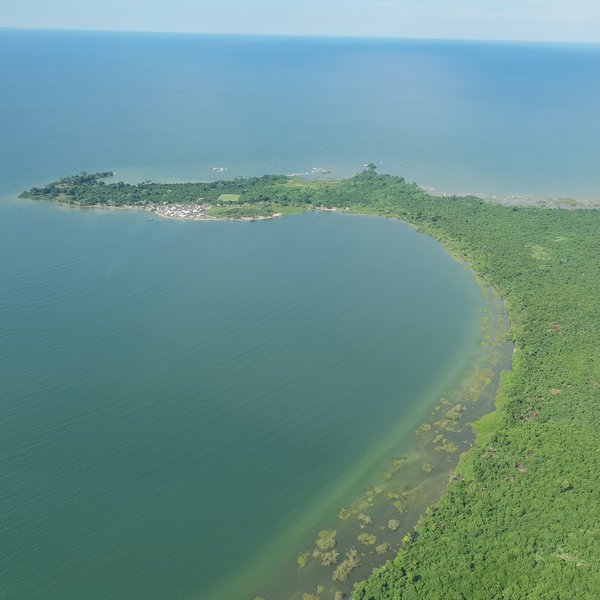

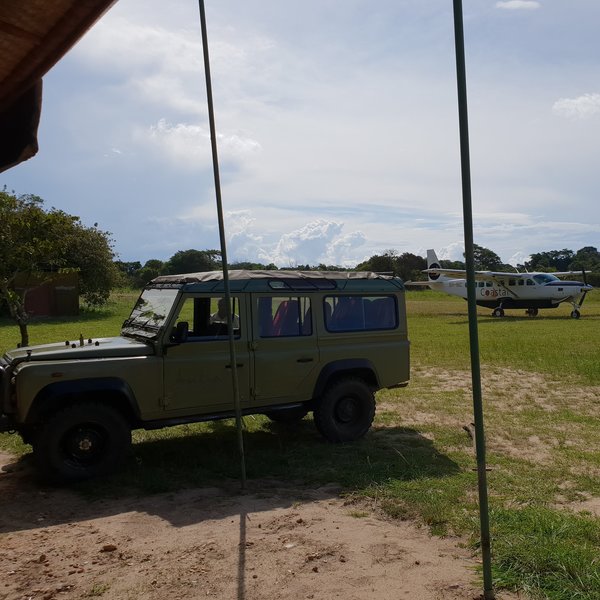
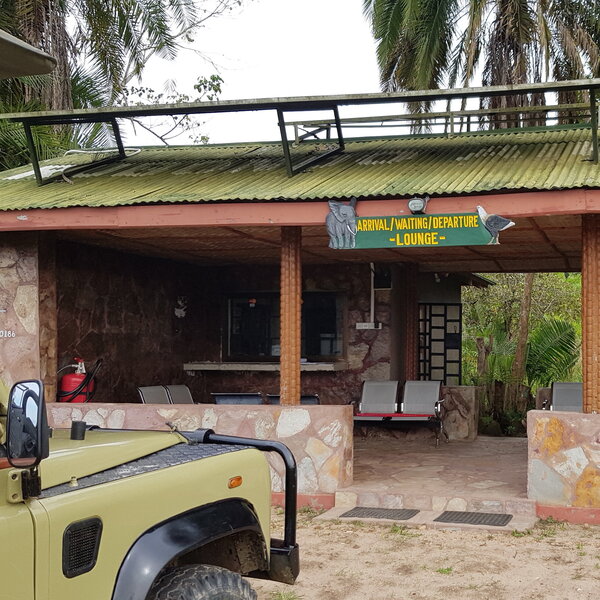
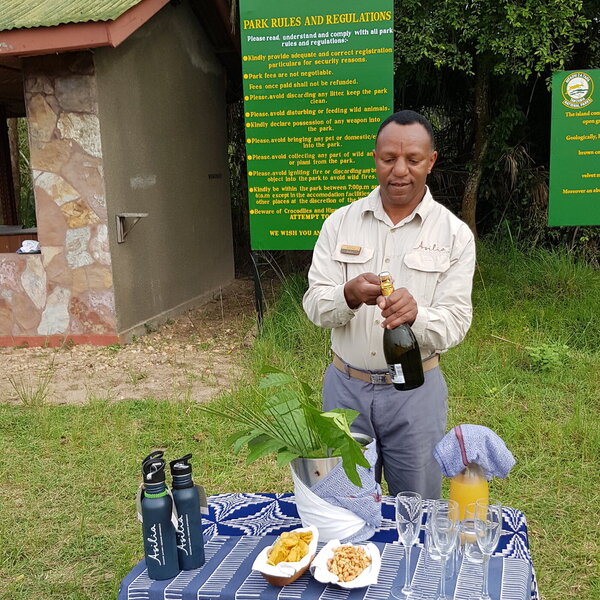
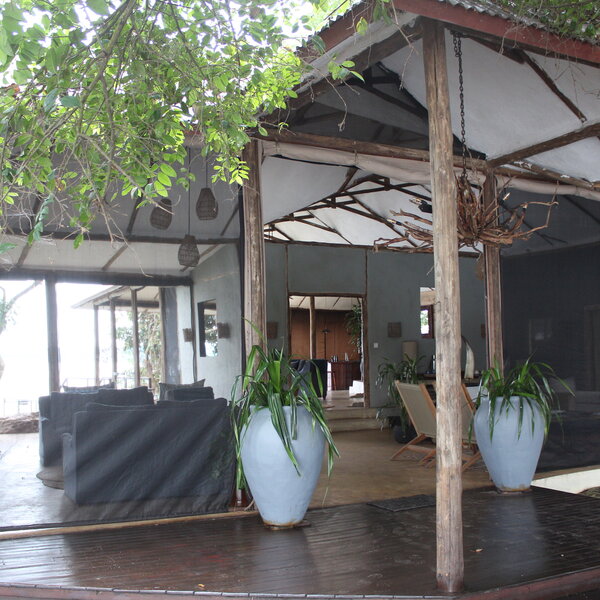
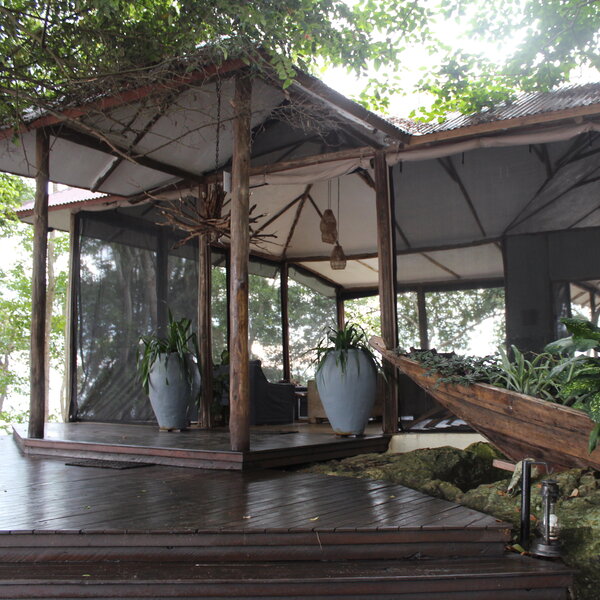
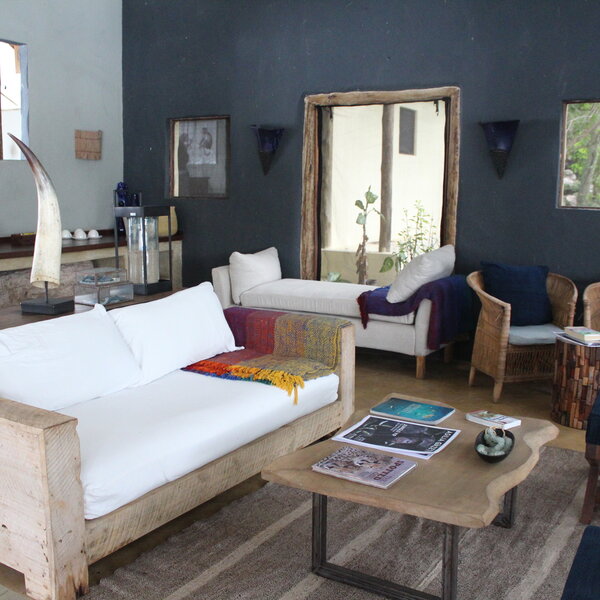
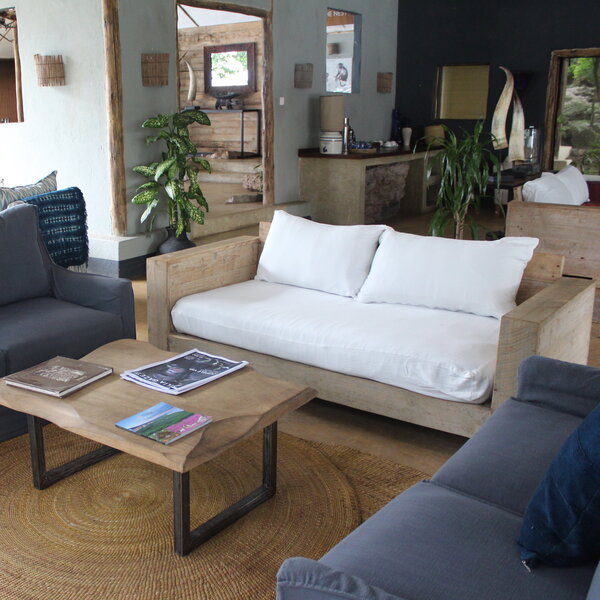
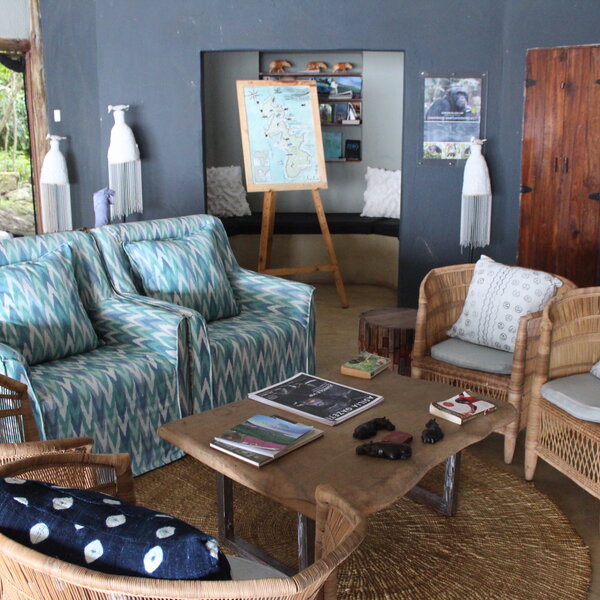
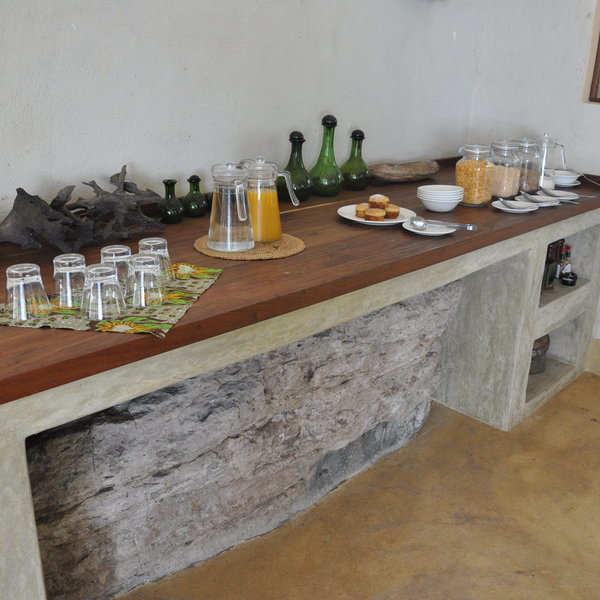
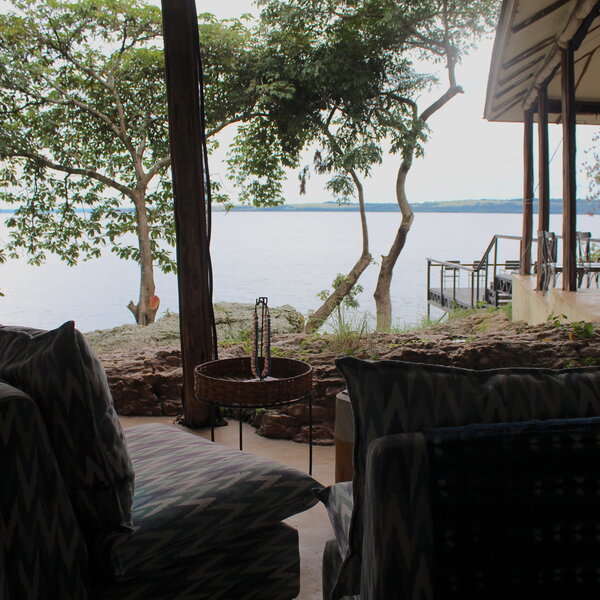
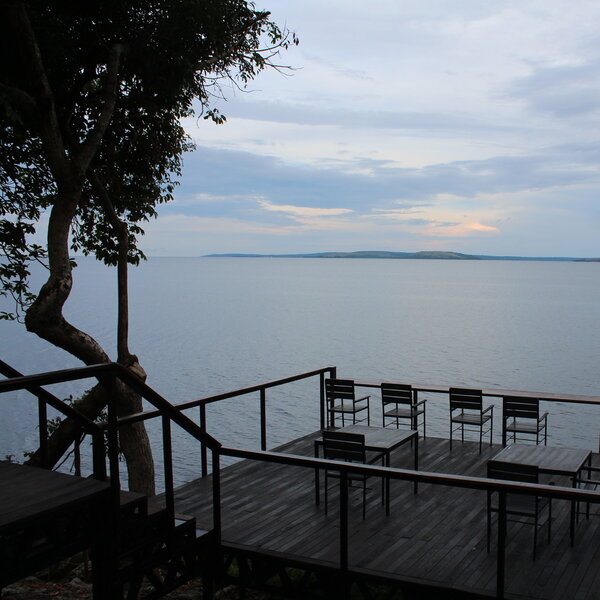
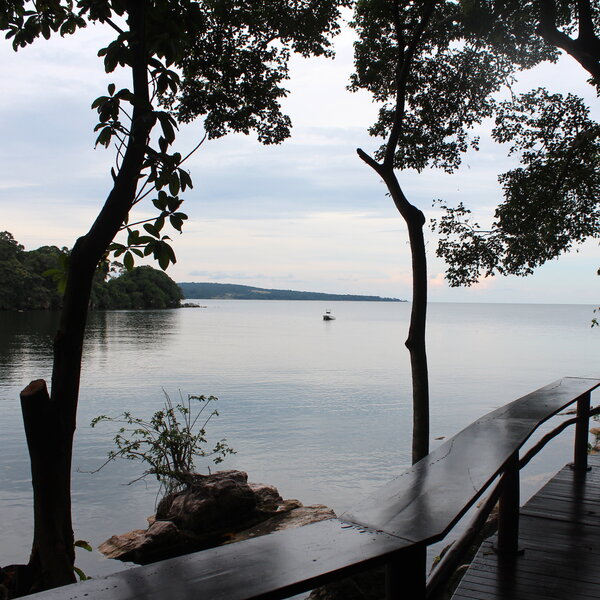
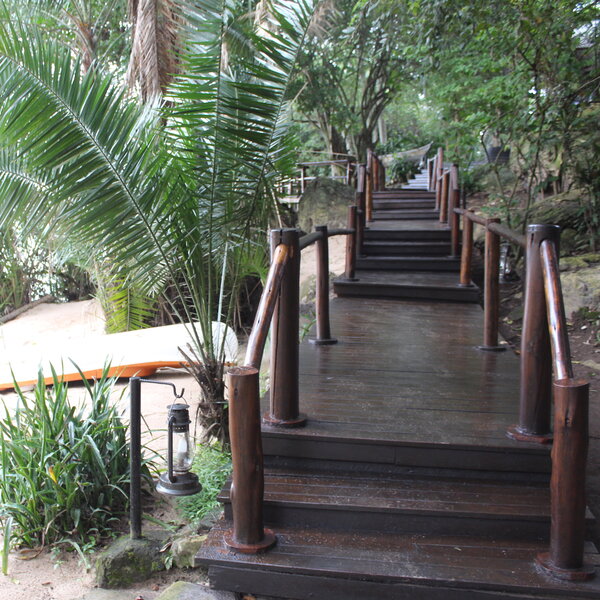

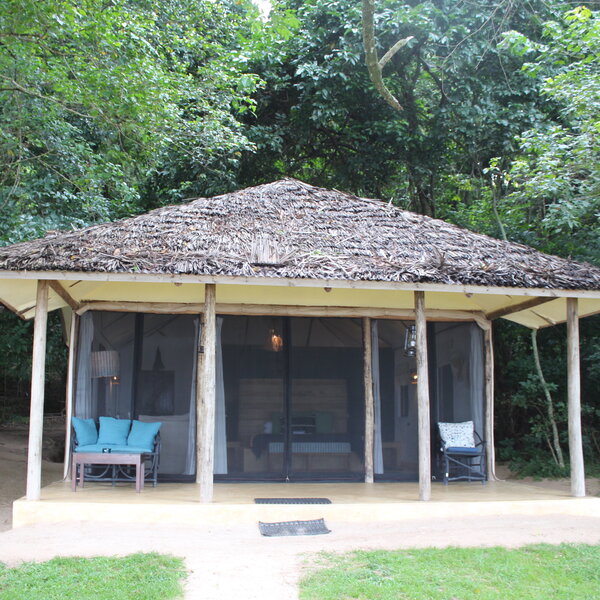

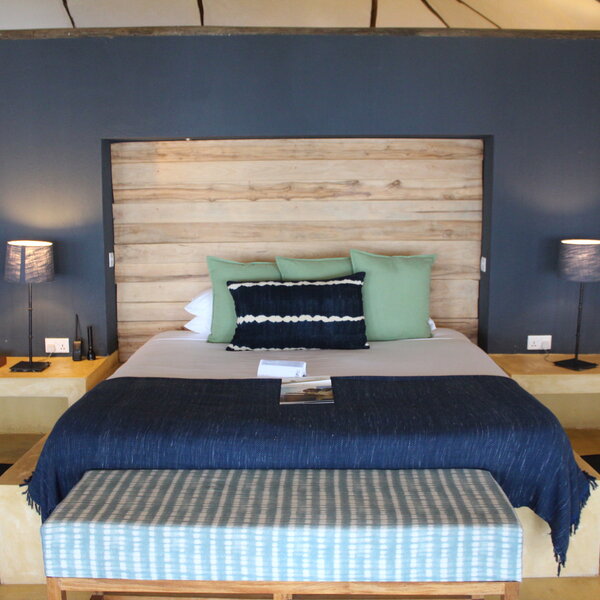


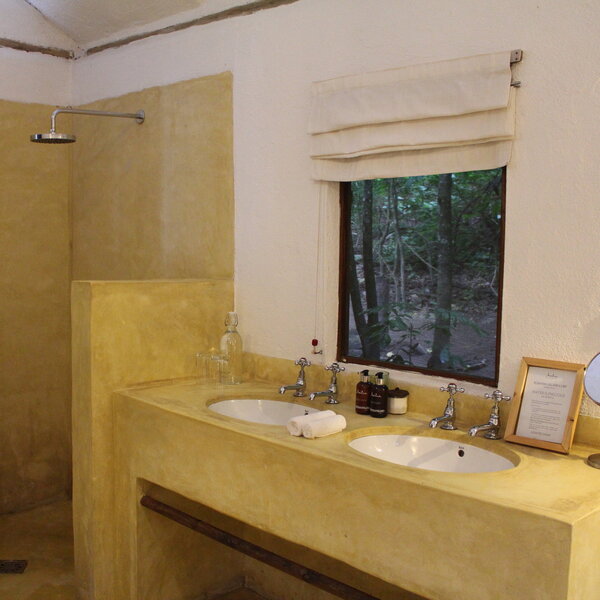
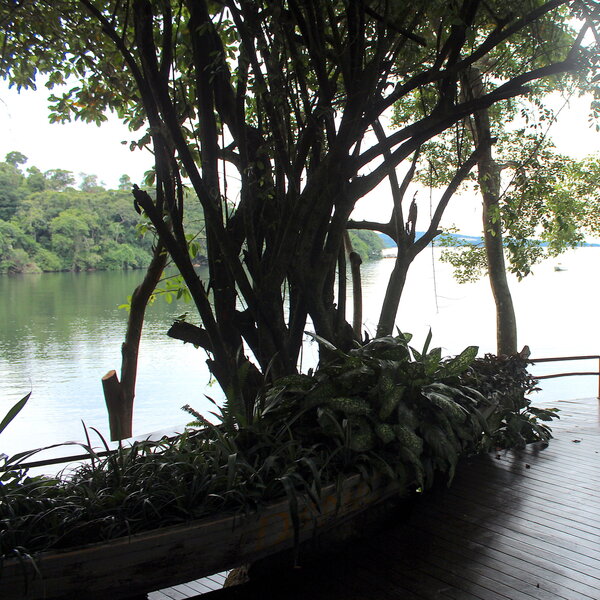
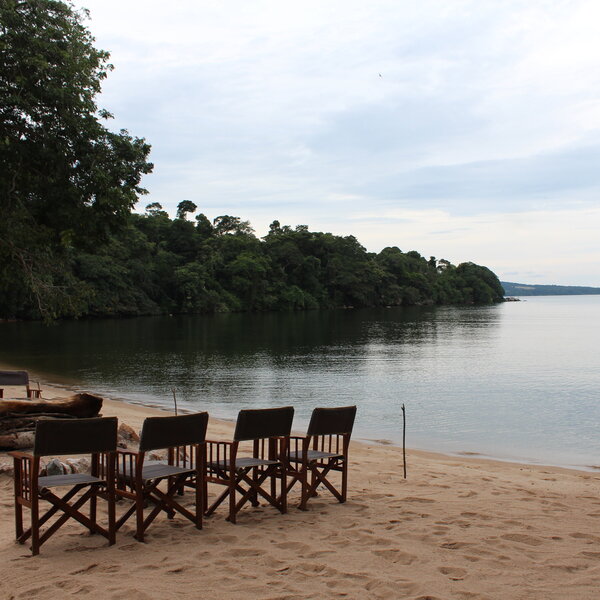
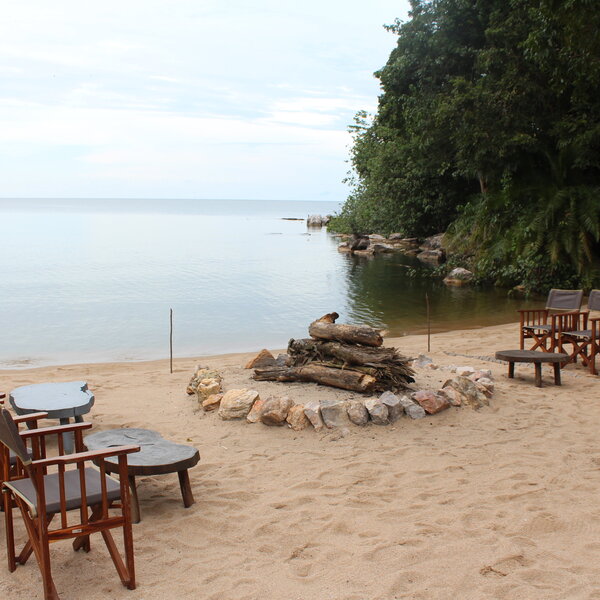
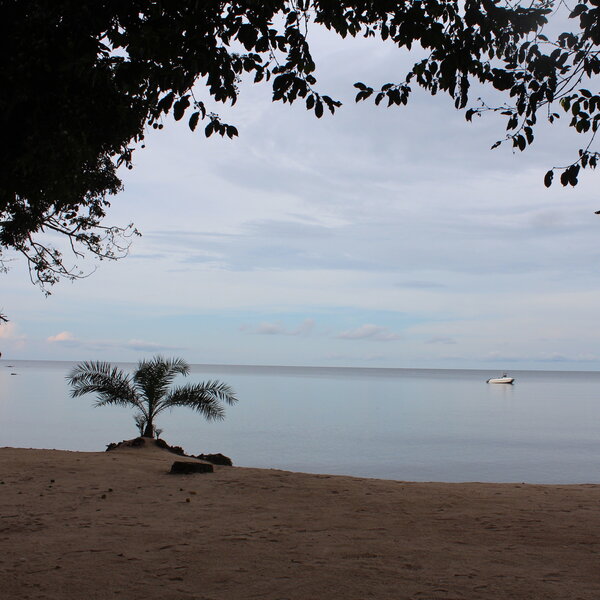
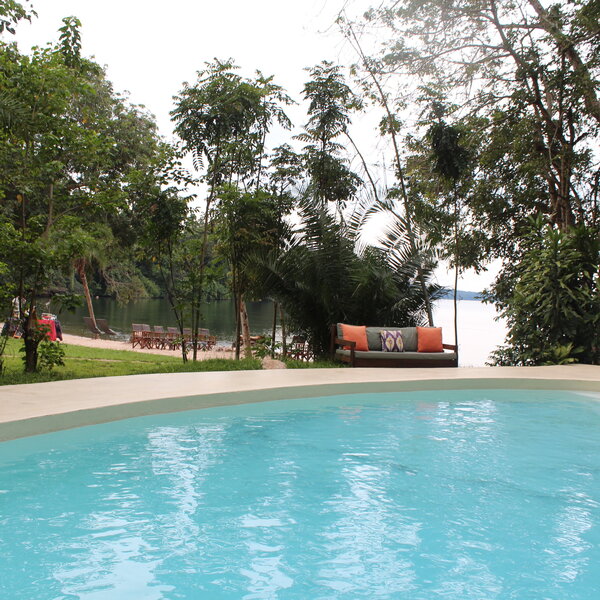

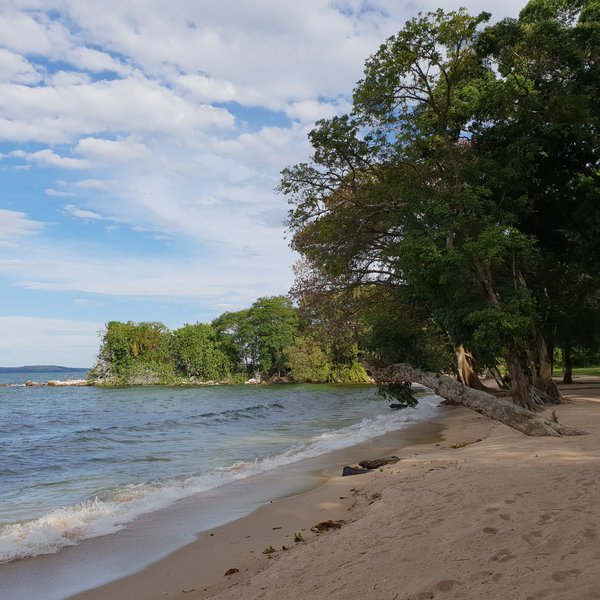
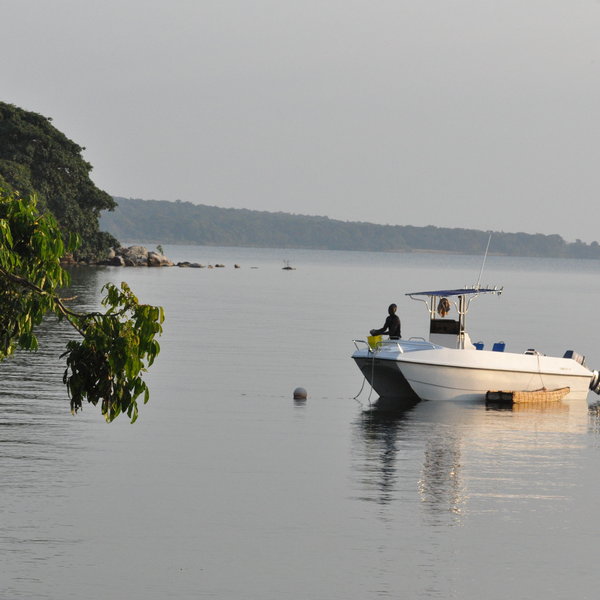
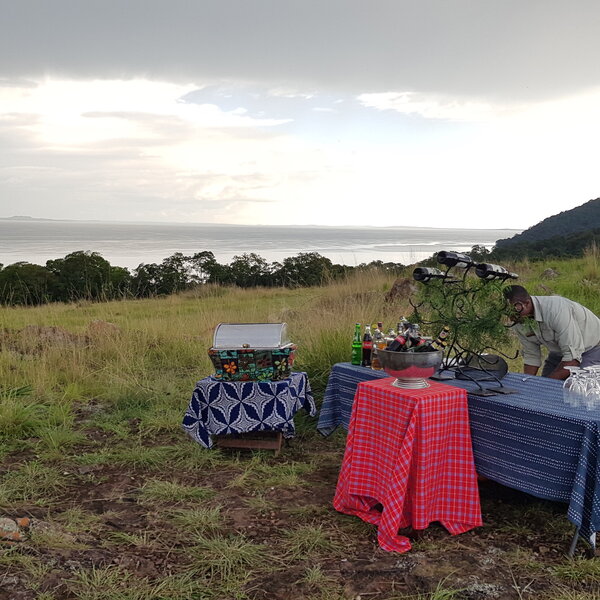
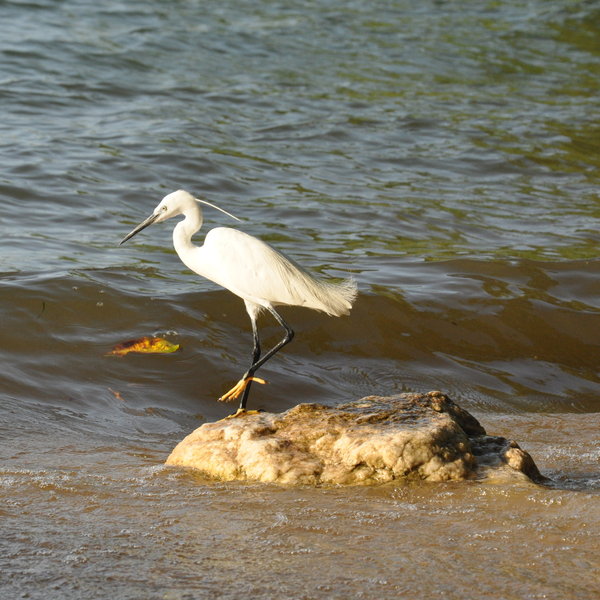
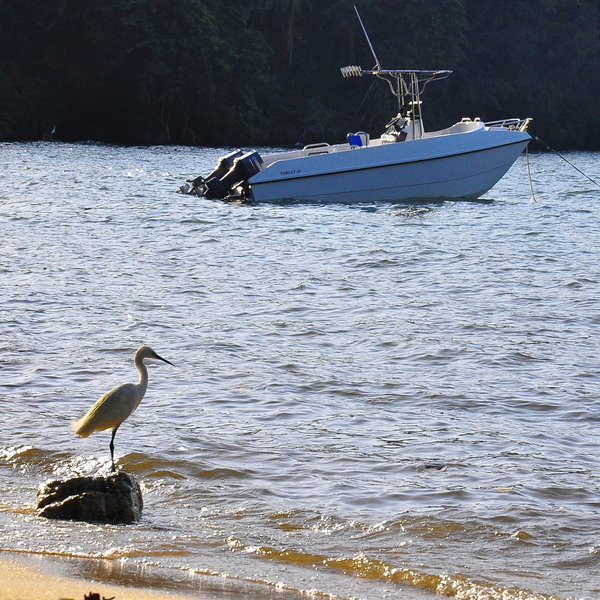
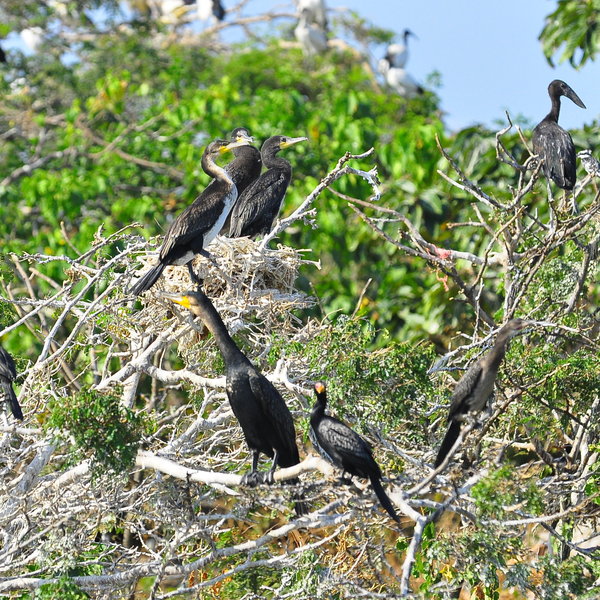
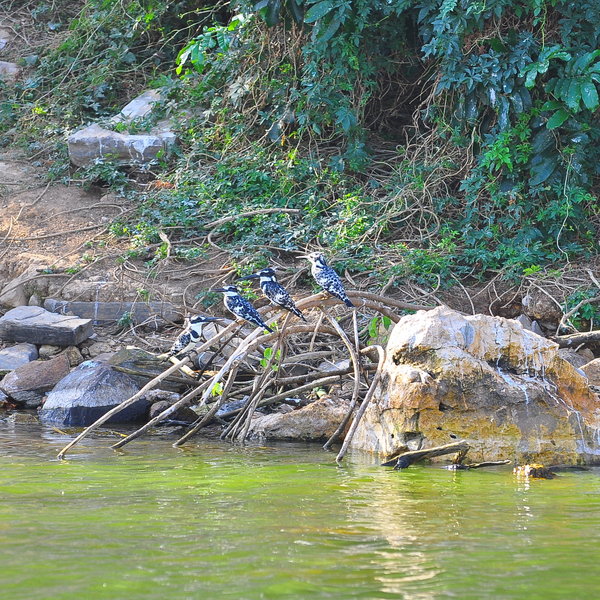
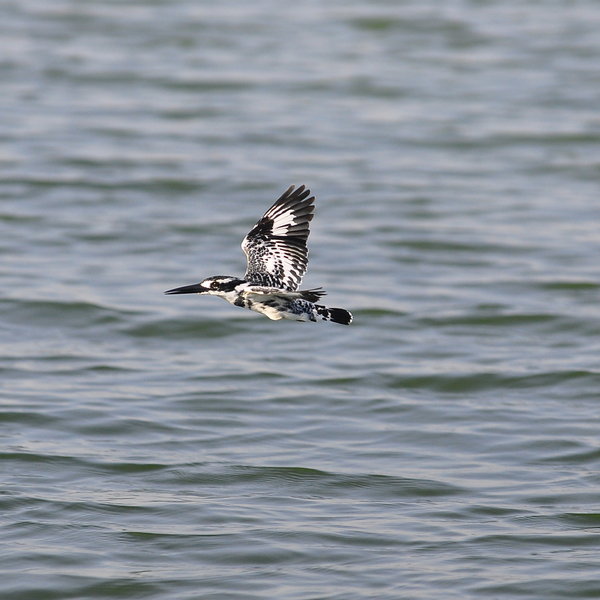
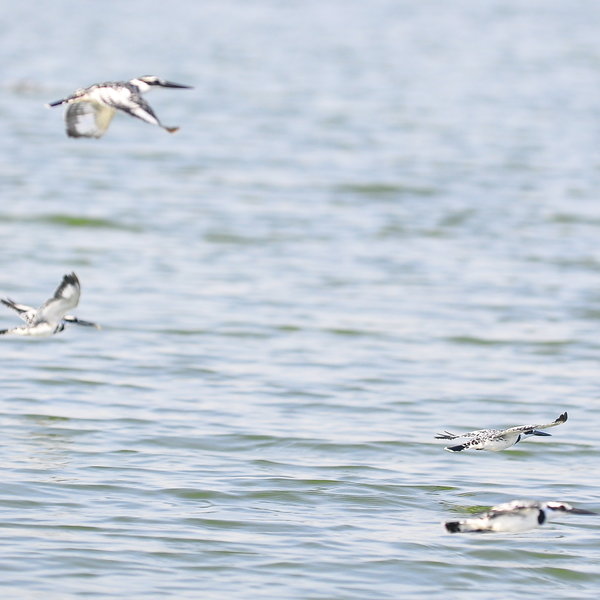
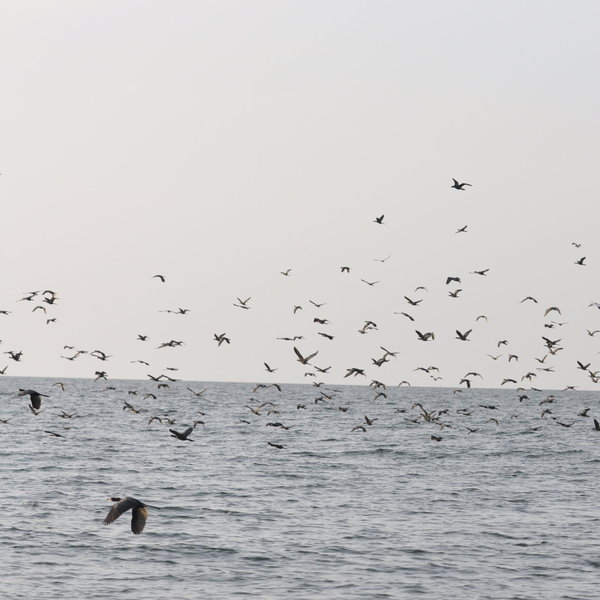
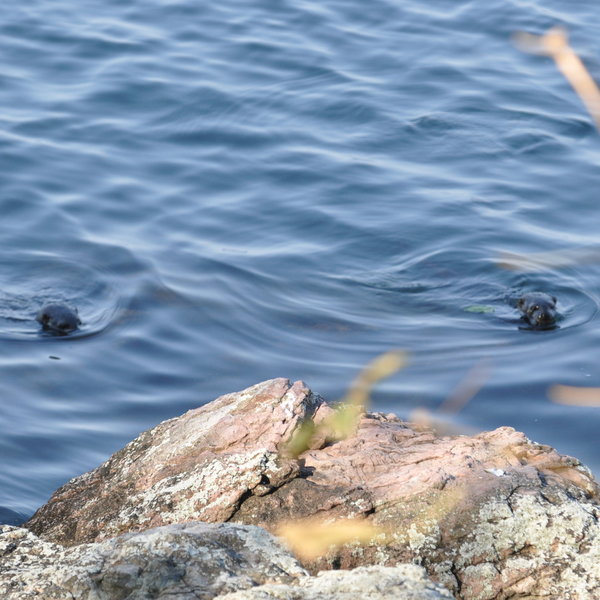
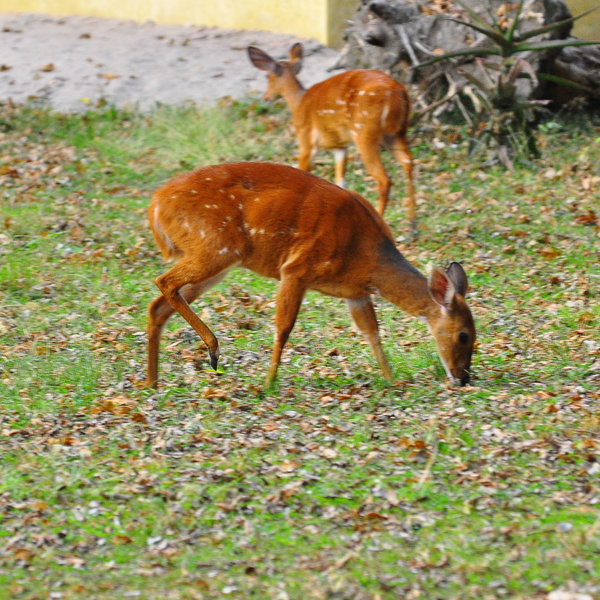
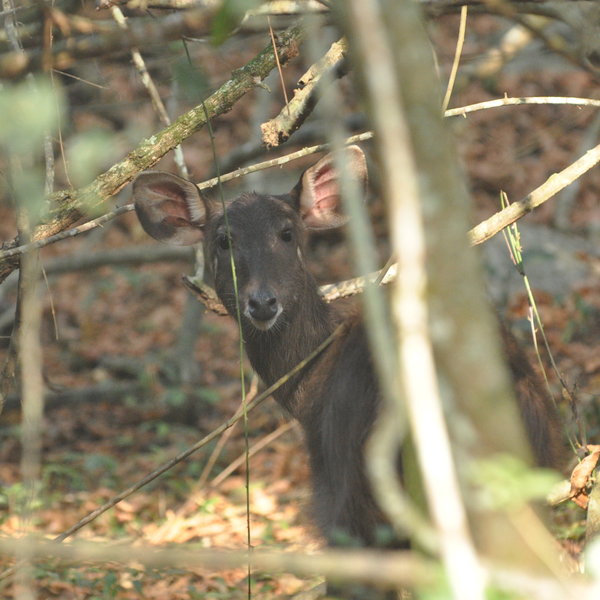
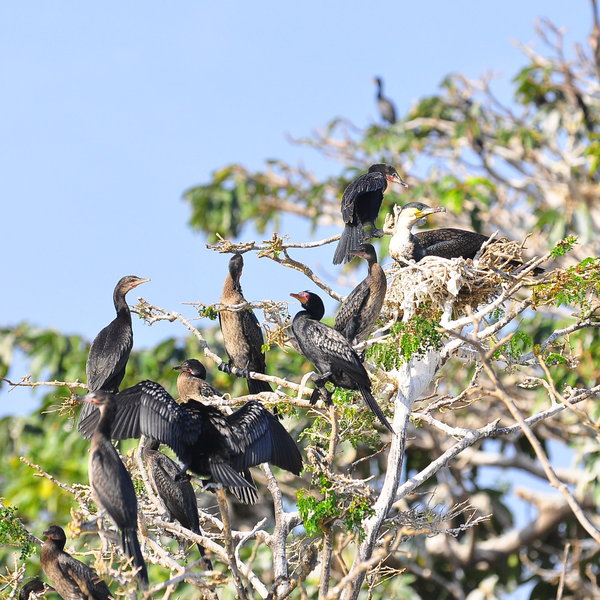
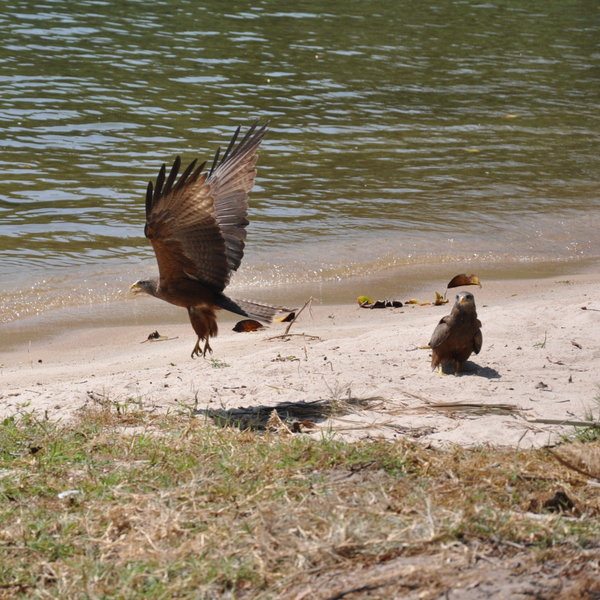
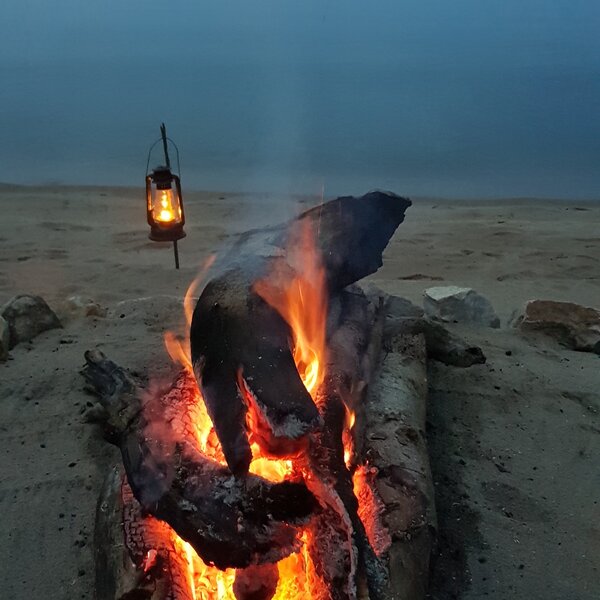
Expert Africa's gallery
When we travel we take lots of photos ourselves to give you a real and un-edited view of the safaris. See our 91 pictures and 1 videos of Rubondo Island Camp to get the candid view.
View galleryRubondo Island Camp: Our full report
Rubondo Island Camp is the only camp on the 250km² Rubondo Island – one of the biggest islands in Tanzania's ...
... vast Lake Victoria. The lodge sits on the sandy lakeshore, backed by dense forest. With some interesting wildlife on the island, including a troop of chimpanzees, and very good birding, it aims to be halfway between a safari camp and a beach retreat.
It is only relatively recently that Rubondo has once again become accessible to the adventurous traveller, after an earlier, very simple camp fell into disrepair and closed. Arriving here is special: it's accessible only by plane, and the birds-eye view as you soar over Lake Victoria and descend to the island is the perfect way to appreciate the geography, landscape and remoteness of the camp. We last visited in November 2018 and had a fantastic time, although it is certainly not your typical safari experience or beach retreat.
Rubondo Island Camp is certainly a unique addition to the typical northern Tanzania circuit. The beach where the camp is located is small but very picturesque, with wildlife aplenty. Towering fig trees are filled with black kites, water monitor lizards scrounge in the bushes, white egrets and open-billed storks wade cautiously at the lake’s edge, and otters can often be seen playing in the reeds. The frequent sound of fish eagles screeching above gives the whole place a primeval feel.
About 60m back from the shore, Rubondo Camp's eight rooms include a family room with two bedrooms sharing a bathroom, and a honeymoon suite with a double outdoor shower. The rooms sit fairly close together, all facing towards the lake and with lovely views, both from the small veranda and from inside through an entirely mesh front wall. Reed-covered roofs and stone walls finished externally in a sandy colour help them to blend into their surroundings.
We do have one niggle, though: as access from the rooms to the main area is along the beach, guests have to walk in front of other rooms, so they don't feel particularly private.
Inside, the rooms are designed in a natural and minimalist style. While there's obviously been a lot of thought put into this, and an attempt made at a clean and contemporary feel, we felt they were slightly lacking in character and a little formulaic, which is a shame given the history and personality of the island.
A double bed forms the centrepiece of the room, with the bedframe and bedside tables crafted from the same stone as the floor, so they appear as one continuous feature. The large headboard that separates the bedroom from the bathroom is painted dark blue, contrasting with the brushed beige and white of the rest of the room. A small writing desk, a bench, a few chairs and a small cupboard complete the furnishings.
The en-suite bathroom behind the bedroom features the same continuous stone walls and comes with a large walk-in shower, twin basins, flush toilet and plenty of space for clothes. Again, they're simple and stylish, but simple items, such as pegs to hang towels on, would be a welcome addition.
Outside, the small veranda, complete with a table and two chairs, is a peaceful place to sit with a book, or perhaps a pair of binoculars. We moved one of our veranda chairs down to the beach to get a bit closer to the shore and get the feel of sand under our feet, but it would be good if there was some form of seating already on the beach.
Between the rooms and the main area there's a very inviting swimming pool around which deckchairs are set out each day.
But it's Rubondo’s main areas, built on a rocky headland, that really stood out for us. Very spacious and set across a number of levels, with sweeping views of the lake on three sides, the lounge, bar and dining areas are peaceful places to take in your surroundings. Large chunks of natural stone poke through the floor, light features made from driftwood, and large potted plants help it to feel like an extension to the natural environment.
The whole structure is completely open, with mosquito-net gauze that can be zipped down in the evenings to moderate the breeze and keep out the insects. Comfortable blue sofas and armchairs sit in small groups on wicker mats, with interesting books laid out on the coffee tables. A small alcove houses ‘The Nest’, with a book swap and games shelf, and information on the island and its inhabitants, particularly the chimpanzees.
Guests usually eat communally, but for those who want a little more privacy, they can also accommodate separate tables. We particularly enjoyed the lower deck on the east side, which is completely open and faces the sunrise, perfect for breakfast, and we also ate at candlelit tables set out on the shore.
Activities at Rubondo Island Camp are far less structured than at most normal safari camps. The atmosphere is about relaxing and enjoying yourself, and simply spending an afternoon in camp, with a pair of binoculars, is a brilliant activity in itself. That said, we did find ourselves occupied all day, every day!
Guided walks around the island focus on the tropical forests and vegetation, whose fantastic birdlife (there are said to be over 300 species on the island) – given the density of the forest – is often heard rather than seen. The two guides in camp during our stay were exceptional and passionate birders, able to identify most species from their call alone.
Vehicle safaris around the island can take you a little further from camp. Sightings of the usually elusive sitatunga and bushbuck are common, while the island’s other mammals, specifically elephant, giraffe, civet, genet and suni antelope, tend to prove a little trickier to find. We were extremely lucky to see several giraffe towards one end of the island, providing great photographic opportunities against the dark, ancient forest. But without doubt the highlight of our vehicle safari was snaking along the bumpy dirt tracks and turning a corner to find a large, male elephant peering at us through the foliage, looking as at home in the forest as any elephant on the savanna. His parting gift was a very large tree that he had pushed across our road back. Such are the events and the adventure that seem to be commonplace on this unusual island.
The chimpanzees on Rubondo Island were introduced in the 1960s. Rescued from zoos and circuses around the world, they have thrived and now more than 40 individuals roam across the island. Visitors can participate in a Chimpanzee Habituation Experience, as against a chimp trek, and sometimes a boat is used to get to a point where you can trek inland. Sightings are improving, although despite many hours of waiting and listening for a characteristic hoot during our recent three-night stay, they couldn’t be located in the thick forest.
The birdlife on some of the smaller islands around Rubondo is exceptional, and heading out on a boat trip from camp is a great way to explore. Bird Island is home to hundreds of cormorants, African darters, egrets, and big flocks of pied kingfishers. Marabou storks lurk in the tall trees, and numerous fish eagles (thought to be some of the highest concentrations in Africa) are spoilt for prey with a lake full of fish, and nests full of chicks. While hippo and crocodiles are only occasionally sighted from the shore of the lodge, they're easy to see from the boat.
For keen fishermen, the 100kg-plus Nile perch that patrol the waters here are a reason to visit, and even the novice angler has a good chance of catching a decent-size fish – as we did. For more serious fishermen, you can privately charter the six-passenger camp boat for US$210 for a half day; while the four-passenger boat costs US$250 for a half day.
Activities
4WD Safari
Birdwatching
Boat trip
Fishing
Fly-camping
Guided walking safari
Kayaking
Primate trekking
Private activities
Families & children
- Attitude towards children
- Rubondo Island Camp welcomes children aged five upwards.
- Property’s age restrictions
- The minimum age is five years.
- Special activities & services
- None.
- Equipment
- There are some board games, colouring book and crayons and a dartboard to entertain children.
- Generally recommended for children
- Despite the beach location, there is not a great deal to entertain children here: this is really more of an adult environment.
- Notes
- Children should be supervised at all times as Lake Victoria is not suitable for swimming, and crocodiles have been known to visit the beach.
Food & drink
- Usual board basis
- Full Board & Activities
- Food quality
- Overall, we were really impressed with the food here, including on our most recent stay in November 2018. It was well cooked, nicely presented and thought had gone into the recipes to make them imaginative. We also liked the way the chef came out after each meal to chat to the guests.
Breakfast usually starts with a fruit platter and tea, coffee and juice. A small buffet has a selection of cereals, after which you can order a hot breakfast (eggs, sausages and bacon) cooked to your preference.
Lunch is a simple set two-course meal. On our first day, we had beef lasagne, with mixed fresh and cooked salads, and fresh bread. The following day we were taken to a grassy headland where we dined on barbecued fish kebabs, pork chops, sausages and grilled aubergines, along with fresh salad and a cold noodle salad. If guests want to go out for a full-day drive or boat trip, it is also possible to organise a lunch pack.
Dinner is a set three-course meal, which on one evening started with cream of butternut soup, followed by grilled beef fillet, steamed rice and mixed vegetables, and with a chocolate mousse to finish. - Dining style
- Group Meals
- Dining locations
- Indoor Dining
- Further dining info, including room service
- Room service is available on request.
Although group meals are the norm, it's perfectly acceptable for guests to request to dine privately. - Drinks included
- Most drinks are included except premium wines and spirits.
Our travellers’ wildlife sightings from Rubondo Island Camp
Since mid-2018, many of our travellers who stayed at Rubondo Island Camp have kindly recorded their wildlife sightings and shared them with us. The results are below. Click an animal to see more, and here to see more on our methodology.

100% success

100% success

100% success

0% success

0% success

0% success

0% success
Getting there
- Location
- Rubondo Island National Park, Tanzania
- Ideal length of stay
- Three nights will give you two full days at Rubondo – enough time to combine their activities with time to relax.
- Directions
- Rubondo is reached by a flight from either Arusha or the Serengeti. It takes around 3–4 hours depending on how many stops the plane has to make.
- Accessible by
- Fly-and-Transfer
Special interests
- Beach holidays
- Rubondo Island Camp has a delightful location in a sandy bay on Lake Victoria. Although the presence of hippos and crocodiles make the water unsafe for a dip, it would nonetheless work for a relaxing beach break in Tanzania.
- See ideas for Beach holidays in Tanzania
- Birdwatching safaris
- The birdlife around Rubondo Island Camp is excellent, making this one of the best places for birdwatching in Tanzania. Boat trips are particularly special, with the appropriately named Bird Island particularly impressive: numerous storks, fish eagles, African darters and egrets.
- See ideas for Birdwatching safaris in Tanzania
Communications
- Power supply notes
- There are plug sockets in all the rooms with 24-hour power.
- Communications
- There is WiFi in the main areas, although it's not always that reliable. There is good cellphone reception throughout the lodge.
- TV & radio
- No
- Water supply
- Borehole
- Water supply notes
- All rooms have flushing toilets and plumbed in showers.
Health & safety
- Malarial protection recommended
- Yes
- Medical care
- There is a first-aid kit at the lodge and the managers and guides are all first-aid trained. They also have links to flying doctors so if there were any serious medical issues, guests could be airlifted to Arusha.
- Dangerous animals
- Moderate Risk
- Security measures
- Askaris (armed guards) walk you back to your room when it is dark.
- Fire safety
- There are fire extinguishers in each room.
Useful info
- Disabled access
- Not Possible
- Laundry facilities
- A full laundry service is included. However, as is usual for Tanzanian camps, underwear cannot be washed, so they provide you with some washing powder in your rooms.
- Money
- There is a safe in the main office where guests can store valuables.
- Accepted payment on location
- Only cash can be used to pay for extras (although they're hoping to get a card machine soon).
Plan and book your trip with Expert Africa
All of our trips are tailor-made, so we'll always adapt them to suit you. Talk to an Expert and let us plan and arrange your perfect trip.

Talk to an Expert
Call or email us now! We’ll match you with the Specialist in our team who is best suited to help you. Then together we can start planning your trip.

Set up your itinerary
Based on our experience and your ideas, your specialist will create a detailed, costed itinerary. We’ll refine it together, until we have a trip that you’re perfectly happy with.

Prepare for your trip
The same Specialist will make the seamless arrangements for your trip, send you detailed travel documents, and be available to answer any questions before you depart.

Travel with peace of mind
After you set off, you’ll be cared for by our partners in Africa, most of whom have worked with Expert Africa for decades. And if you ever need us urgently, we’re available 24/7.

When you return
We love to learn about your trip, and so will always be grateful if you’ve the time to give feedback to your Specialist when you return.
Rubondo Island Camp's location
Look closer at the environment and surroundings of Rubondo Island Camp.
Excursions from Rubondo Island Camp
Optional extra day-trips and excursions possible whilst you're staying at Rubondo Island Camp. Talk to us: these are usually best arranged before you go.
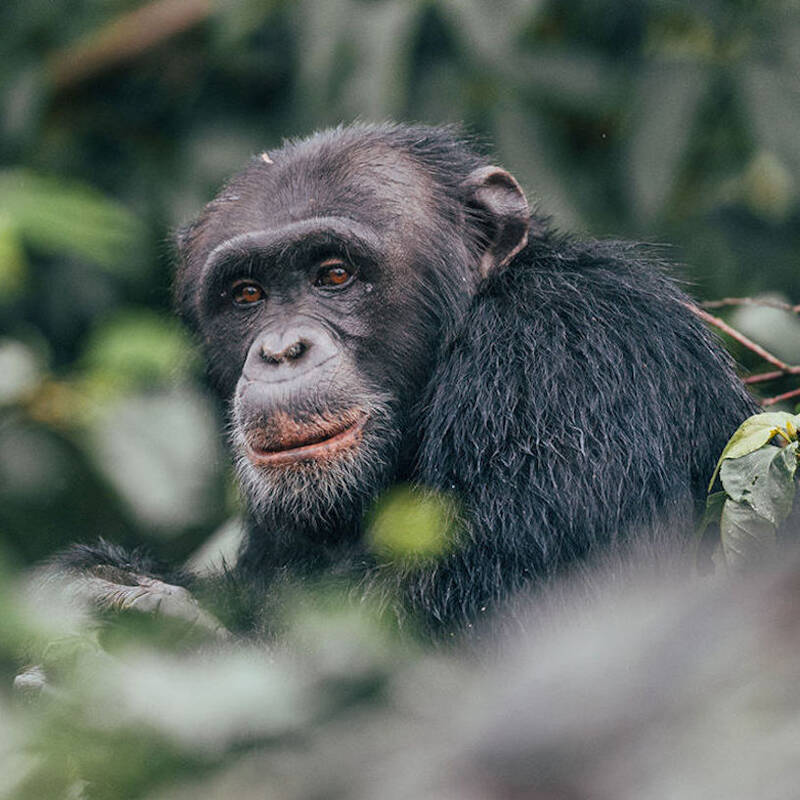
Chimpanzee habituation experience
One or two days
A chance to catch a glimpse of a unique group of chimpanzees that are in the process of being habituated on Rubondo Island. Trek, in search of these remarkably human-like creatures, follow their calls, and with luck spend some time watching them in their natural environment.
More about Chimpanzee experienceWhen to go to Rubondo Island National Park
Our month by month guide: What it's like to visit Rubondo Island Camp in Rubondo Island National Park
Jan
Feb
Mar
Apr
May
Jun
Jul
Aug
Sep
Oct
Nov
Dec
Tanzania in January
January usually marks the start of the short dry season, although the exact timings of this are a little unpredictable. You can expect clear blue skies and sunshine, if the short rains have stopped, and the temperatures will be building. The short dry season is a little less pronounced in Southern Tanzania, and so it can still be wet in these areas. It is an interesting time for avians as resident birds go into breeding plumage and migrant species can be present.
Once the New Year busy period has quietened down, January can offer great value and quieter parks, although the weather can be variable, and in the Selous and Ruaha the wildlife is more dispersed.
- Variable weather: clear & dry or cloudy with some rain.
- Occasional thunderstorms may occur.
- A good time of year for birding as and many migrant species are around
- The wildebeest migration is gathering in the southern Serengeti.
- Busy in early January, quietening down through the month.
Our view
A good time to visit, with pros & cons
Weather in January
Tanzania in February
February is during the short dry season and is one of the hottest months in Tanzania, with temperatures reaching around 33°Celsius. This can be a good time to visit, as some areas of the Northern Circuit are comparatively quieter than during the European summer months, and lodge rates are also a little lower.
The wildebeest will typically be on the southern plains of the Serengeti for their calving season, which tends to occur in a 2-3 week window in early-mid February – although this does vary year on year. This is also a particularly rewarding time for birdlife, as northern hemisphere migrants join the resident species.
- Hot and dry weather.
- Wildebeest migration calving on Serengeti’s southern plains.
- Ngorongoro Crater and southern Serengeti busy for the migration.
- Selous and Ruaha are typically quiet at this time.
- The parks are likely to be lush and green, leading to pretty landscape
Our view
A very good time to visit
Weather in February
Tanzania in March
The heavier ‘long rains’ start in earnest in March although exactly when varies year on year. With no need to stay close to permanent water sources, migratory wildlife disperses, and so game viewing starts to become more challenging. This is most prominently seen in Tarangire National Park. The wildebeest migration may still be calving, or have moved on into the central regions of the Serengeti.
Many of the camps in the southern parks close mid March and mobile tented camps in the Serengeti will wind down towards the end of the month in order to move location or carry out refurbishments, ready for the new tourist season.
- Hot with building humidity, before the rains begin at some point.
- Wildlife viewing is variable depending on the start of the rains.
- Parks are quiet and rates are low.
- Not great for southern or western Tanzania.
- March can be a good time for birding, with many migrant species.
Our view
A good time to visit, with pros & cons
Weather in March
Tanzania in April
April is in the middle of the long rainy season and is the wettest month, with on average 250mm of rain. Temperatures are fairly high and humid in comparison to the rest of the year. Expect the bush to be lush and flowering, and alive with insects, birds and smaller animals. It is however also dense, allowing wildlife to hide, which in turn makes game viewing harder. This is a very quiet time in terms of visitor numbers.
Many of the tented camps are closed in April, however the larger lodges remain open. The rates are significantly cheaper, and so if you are willing to work harder to spot the bigger game, some accommodation bargains can be had.
- Heavy rain expected, with impressive thunderstorms and lightning.
- Many camps closed and roads impassable due to ground conditions.
- Rates are at their lowest all year round, with very few other tourists
- Places that are open are green and vibrant, wildlife more dispersed.
Our view
This is not a great time to visit
Weather in April
Tanzania in May
As Tanzania is close to the equator there is no dramatic difference in climate throughout the year, but temperatures do start to drop a little in May. The rains are likely to still be present, although potentially clearing towards the end of the month. Visitor numbers and lodge rates are still low. The wildebeest migration is making its way through the western regions of the Serengeti, crossing the Grumeti River.
Virtually all camps in southern Tanzania remain closed, and many of the roads and tracks in the Selous become impassable.
- Heavy rains and storms are likely, this can create some dramatic skies
- Blissfully quiet in northern Tanzania, and a good time to avoid crowds
- The parks are likely to look lush and green, with long grass.
- Wildlife is likely to be more dispersed, with fewer sightings.
- The low prices make safaris much more affordable at this time.
Our view
This is not a great time to visit
Weather in May
Tanzania in June
The rains come to an end at some point during the month and migratory wildlife begins to be drawn back to perennial water sources as the land starts to dry up. It’s likely that the parks will still be quite green and the grass high though, so walking and fly-camping may be unlikely. This marks the start of the season with camps reopening, but prices are still more affordable than the subsequent months.
The migration may still be in the Western Corridor, or on the move northwards towards the Mara River. Western Tanzania presents more challenging conditions for chimpanzee trekking in Mahale National Park, as the chimps are higher in the mountains.
- Variable weather: clear & dry or cloudy with some rain.
- A transitory time for the migration – moving from west to north.
- The parks may still be quite green, and grasses high.
- Wildlife may be dispersed still.
- Relatively low visitor numbers and good value, shoulder season prices.
Our view
A good time to visit, with pros & cons
Weather in June
Tanzania in July
July is considered to be the start of the peak season, with no rainfall expected and pleasant daytime temperatures. As the parks dry, the wildlife congregates in fewer areas, grass is eaten and trampled by the migration, and game viewing gets better and better. The wildebeest are typically arriving in the northern Serengeti, ready to begin their period of crossings of the Mara River.
In the Selous and Ruaha wildlife sightings can be fantastic, with animals gathering around the lakes and rivers. Great conditions and school holidays mean the parks are at their busiest, with Ngorongoro and the Serengeti particularly crowded.
- Dry and warm daytimes, chilly and windy in the mornings and evenings.
- Great wildlife viewing, as water sources diminish.
- The most popular time of year with very high visitor numbers.
- Prices are at their highest due to the great conditions on the ground.
- To avoid the crowds consider Tanzania’s southern parks.
Our view
Fantastic: the very best time to visit
Weather in July
Tanzania in August
August is the middle of the long dry season, with clear skies and sunny weather. You can expect some cooler weather at night and first thing in the morning. Remember to pack layered clothing, so you can wrap up warm on your early morning game drives, but remain comfortable as it heats up throughout the day.
August is a very popular time to visit, so accommodation prices are at their highest and advanced booking is necessary. It can get noticeably busier in some of the northern parks – in particular the Ngorongoro Crater and northern Serengeti, as visitors flock to the area in hope of witnessing an exciting migration river crossing.
- Dry and warm daytimes, chilly in the early mornings and evenings.
- General wildlife viewing should be excellent.
- An exciting time of year for the wildebeest migration.
- Certain areas will be very busy and camps fill up fast.
- Great wildlife sightings in the Selous and Ruaha, and fewer people.
Our view
Fantastic: the very best time to visit
Weather in August
Tanzania in September
September can be an excellent time of year to visit Tanzania. As the parks continue to dry up the wildlife becomes increasingly reliant on the remaining water sources, leading to high densities of animals. Whilst early September can be busy, with fewer families traveling at this time the parks typically become quieter as the month goes on.
You are still likely to see the wildebeest migration in the northern Serengeti, with river crossings occurring on a regular basis. Tanzania’s southern parks are also fantastic at this time of year, generally receiving far fewer visitors than the north, and wildlife sightings can be great. Prices remain high and the weather generally remains good.
- Wildlife viewing in September can be fantastic.
- Whilst still fairly busy, often the parks are typically a little quiet
- The parks will start to become very dry, with little new vegetation
- Cooler mornings and evenings, warming up during the day.
- Prices remain high.
Our view
Fantastic: the very best time to visit
Weather in September
Tanzania in October
At the tail end of the dry season, the wildlife should be the easiest to spot, although photographers should be aware that it can be a bit dusty at this time of year, as there has been no rain for several months. Great general wildlife viewing throughout as animals are attracted to remaining sources of water. Elephant numbers are particularly high at this time in Tarangire, and Mahale and Katavi are especially rewarding with frequent wildlife sightings close to camp.
There is a chance of rainfall towards the end of the month, if the short rains commence. While prices remain high, visitors numbers are significantly lower than in July-August.
- Mostly dry and temperatures comfortably warm, with the chance of storm
- Great game viewing although the landscape can be a bit barren.
- Much lower visitor numbers than the earlier months.
Our view
A very good time to visit
Weather in October
Tanzania in November
In November you can expect the start of the short rains, although the start date varies every year. The rains are highly localised, and are much lighter and more unpredictable than the long rains that occur earlier in the year. These should not really interfere with your safari – as the game viewing at this time is still good - but you should pack a waterproof jacket and be prepared for some short rain showers!
The majority of tented camps remain open, but some of the mobile camps in Northern Tanzania will close for the latter half on the month. Given the seasonality, camps are charging shoulder season rates so there are often some bargains to be had. Early November can offer great value for money and the weather conditions are likely to be comparable to late October.
- Variable weather: clear & dry or cloudy with some rain.
- Parks are comparatively quiet and prices at the lower end.
- Some camps will close towards the end of the month for maintenance.
- Good wildlife sightings, but animals will disperse when rain starts
- The wildebeest migration is on the move and the location unpredictable
Our view
A good time to visit, with pros & cons
Weather in November
Tanzania in December
December is also during the short rainy period, but this does not stop Tanzania being a popular destination to spend the festive period. Be aware that many of the lodges book up early, and charge peak rates over this time. Advanced booking is essential over this period, especially if travelling in larger family groups.
Travelling in December outside of the festive period allows travellers to make use of excellent shoulder season rates. Temperatures are pleasant with the averages of 27Celsius, although there is the chance of intermittent thunderstorms.
- Variable weather:clear & dry or cloudy with some rain and thunderstorm
- Good general game viewing in parks with low seasonality - Serengeti.
- Very quiet early in the month, becoming exceptionally busy.
- Prices reflect this – great value rising to the highest they are.
- The wildlife in southern Tanzania is more dispersed.
Our view
A good time to visit, with pros & cons
Weather in December

Looking for inspiration on where to travel next?
Visit our trip chooser to explore your options and find inspiration for your perfect African adventure
Inspire me